Choosing an optical reflectometer for passive optical PON networks
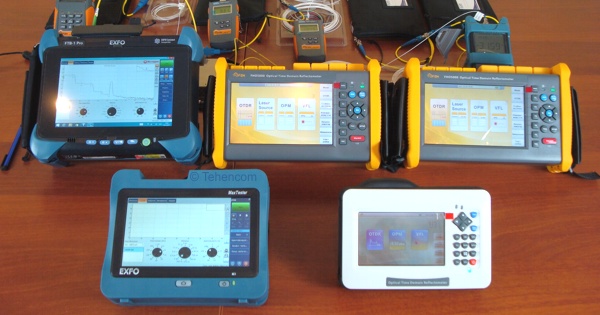
Brief introduction
This is the second article in a series of articles on testing passive optical PON networks. It presents the results of measurements of five models of reflectometers with operating wavelengths of 1310 nm and 1550 nm, which are used to measure an inactive PON network during the construction phase, or to diagnose a non-working branch of an operating network when troubleshooting. The test deliberately presents reflectometers of all price ranges: from economy models Grandway FHO3000-D26 with a dynamic range of 26 dB to the professional EXFO MaxTester MAX 730C with a dynamic range of 39 dB, which is equipped with a PON-optimized measurement module.
Choosing an OTDR for a PON is not an easy task. After all, the PON network contains dividers (splitters), which lead to significant attenuation of test reflectometric pulses, which is a serious test for any reflectometer model, even with a large dynamic range. On the other hand, PON network dividers are often located close to each other, sometimes at a distance of less than 100 meters. This further complicates the task of accurate measurement, as it requires a minimum dead zone from the reflectometer.
The results of real measurements, which are given on this page, will help you choose the optimal reflectometer model, as well as avoid a situation where the actual capabilities of the purchased device do not correspond to its declared characteristics. The PON network simulator was used as the measurement object with a total division factor in the branch equal to 128. A detailed description of this simulator is here. The following are test results for inactive fiber at wavelengths of 1310 nm and 1550 nm. At the end of this article there is a summary with conclusions. Test results active fiber at wavelengths of 1625 nm and 1650 nm will be published in a separate article.
EXFO MAX 730C measurement results with 39 dB dynamic range
Optical reflectometer MaxTester 730C developed by EXFO specifically for measurements in PON networks. This reflectometer has an ideal dynamic range (39 dB) for testing PON networks and a special detector, the dead zone of which is optimized for test pulses with a duration from 100 ns to 1 µs. The EXFO MaxTester 730C series has models with working wavelengths of 1310/1550 nm, as well as models with additional wavelengths of 1625/1650 nm.
The measurement results of this reflectometer are given first, since this the only model, which was able to accurately measure the loss of each of the three splitters, with a total division factor of 128. The best results (minimum dead zones in the absence of noise after the third splitter) were obtained with a test pulse duration of 1 µs (1,000 ns). To reduce noise, a long averaging time of 180 seconds was set.
A screenshot of the reflectometer screen with measurement results is shown below. On this trace, the first 1x8 divider is located at a distance of 500 meters and is marked as event No. 2. The second divider 1x8 is located at a distance of just over 1.5 km (event No. 4). The third 1x2 divider (event #5) is located at a distance of about 2.1 km. This reflectogram can serve as a reference, since other models of the tested reflectometers could not show such a result.
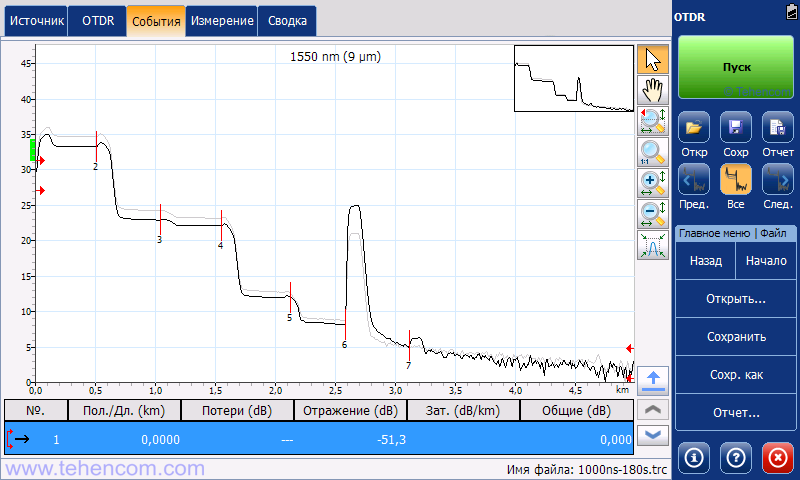
For maximum accuracy, we manually placed markers and measured the loss on each splitter using the four-point method. The results are shown in these three screenshots. It should be taken into account that the measured losses, in addition to the losses of the splitter itself, also include the signal attenuation on the two optical connectors with which this splitter is connected. And the second thing to keep in mind: splitters are not symmetrical devices. Losses in the direction from the station to the subscriber are different from the losses in the opposite direction (from the subscriber to the station), so the results of the most accurate reflectometric measurements will differ slightly from the nameplate data of the splitters, which are given in the detailed description of the one we use PON network simulator.
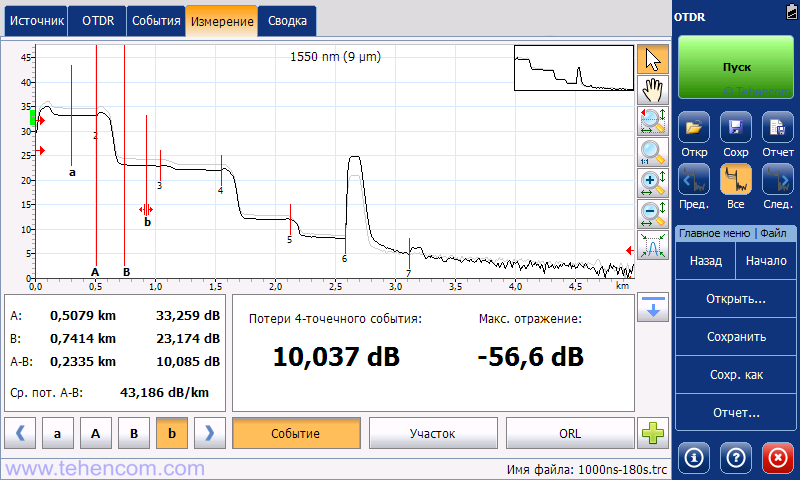
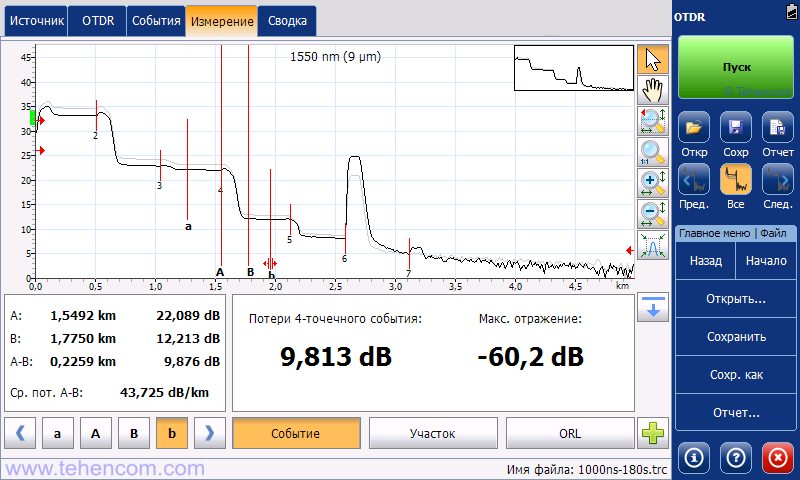
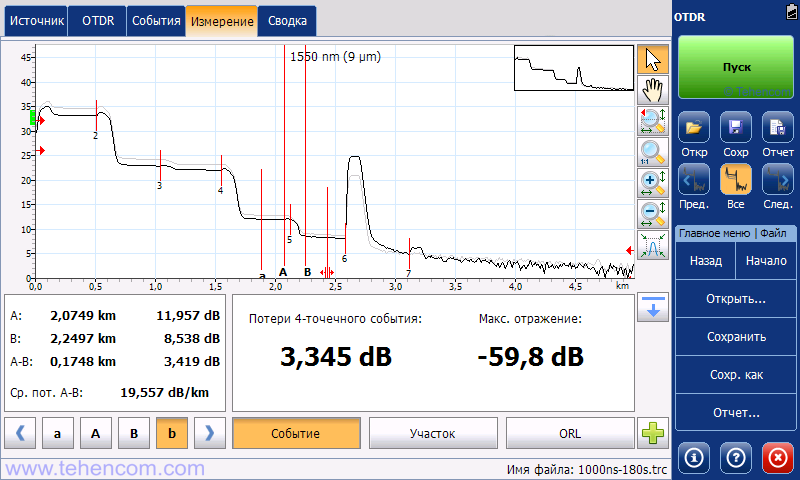
If your PON network has splitters located at a distance closer than 200 meters from each other, then to reduce the dead zone of the reflectometer, you will have to reduce the duration of the test pulse, since a pulse of 1,000 ns will not allow you to distinguish the losses of one 1x8 splitter from another. But with a decrease in the pulse duration, the effective dynamic range of the reflectometer will automatically decrease and it will be more difficult for the device to measure the far section of the fiber: the noise level will increase and the accuracy will decrease.
To show the dependence of the quality of the reflectogram on the duration of the probing pulse, we carried out a group of measurements with different pulses: 50 ns, 100 ns, 275 ns, 500 ns, 1000 ns (1 µs) and 2500 ns (2.5 µs). The averaging time was 30 seconds for each of the two wavelengths. The results are presented in this table. .
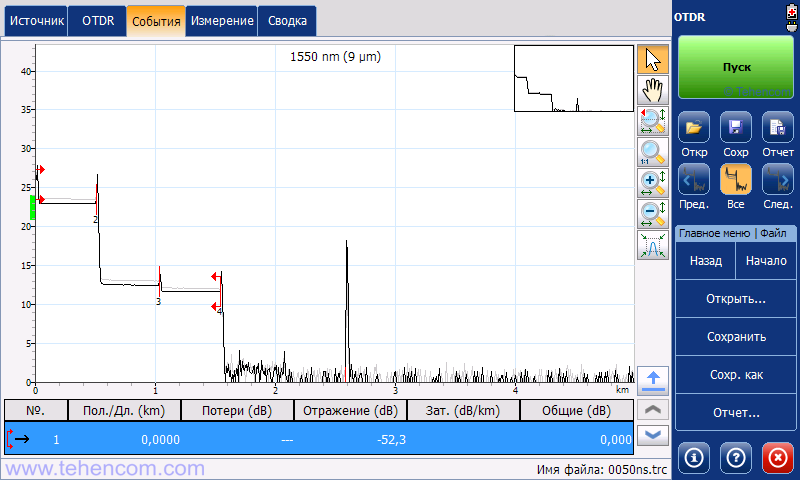
Test pulse 50 ns. Click to enlarge. |
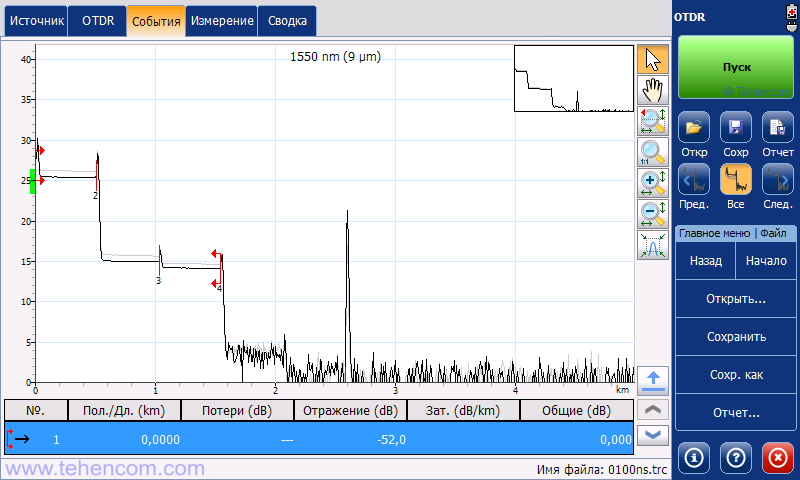
Test pulse 100 ns. Click to enlarge. |
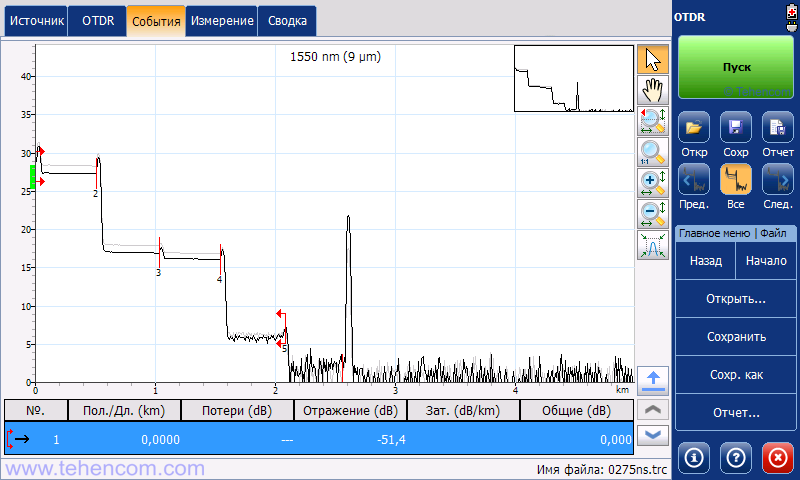
Test pulse 275 ns. Click to enlarge. |
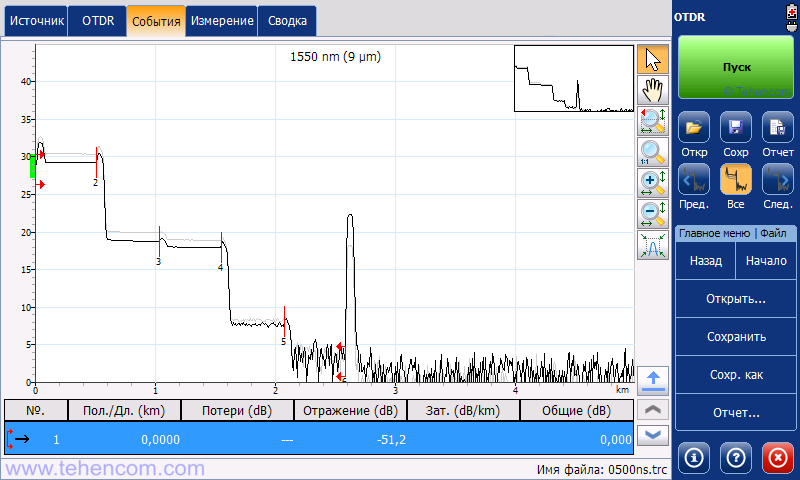
Test pulse 500 ns. Click to enlarge. |
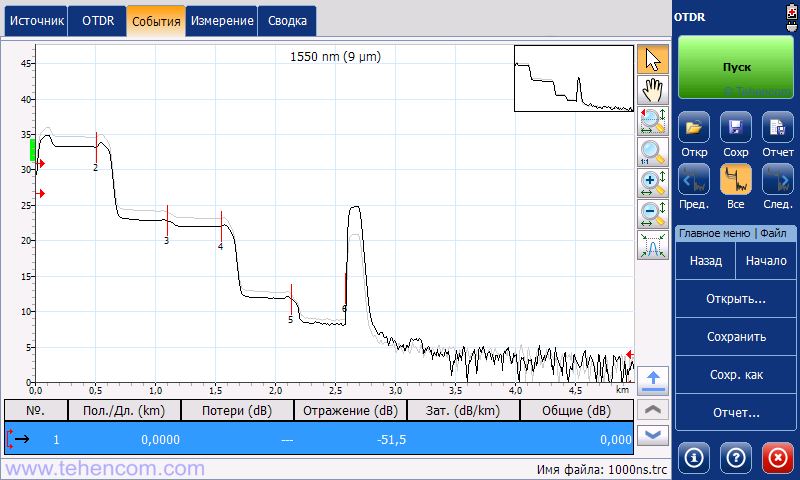
Test pulse 1000 ns (1 µs). Click to enlarge. |
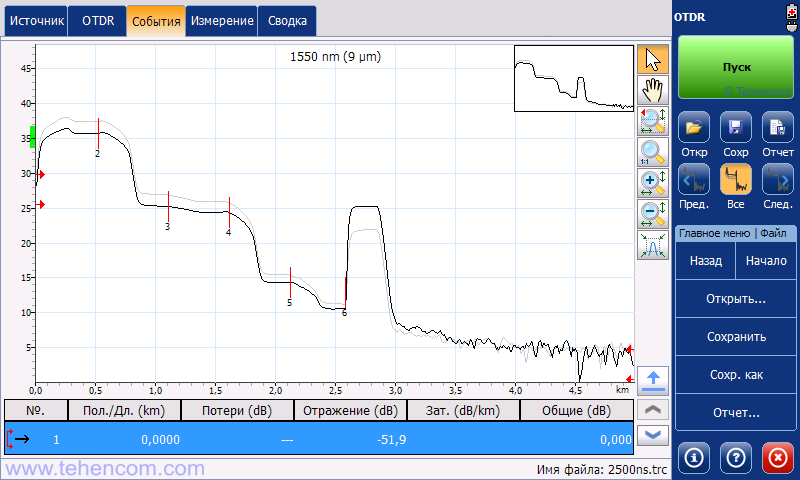
Test pulse 2500 ns (2.5 µs). Click to enlarge. |
Conclusions on the test results of the EXFO MaxTester 730C reflectometer. This reflectometer will fully cope with the measurements of any PON networks, even with a maximum division factor of 128. If it is necessary to test only the subscriber section and the first 1x8 divider, then the pulse duration of 50 ns is optimal. With this pulse duration, the illumination from the 1x8 divider is only 35 meters, and if the second divider in the branch is at a greater distance, then the losses of the first divider can be accurately measured. If it is necessary to carry out measurements through two 1x8 dividers, then a pulse of 275 ns or 500 ns can be used, while the distance between the dividers should be more than 60 and 90 meters, respectively. For end-to-end measurement of PON networks with a common division ratio in branch 128, a test pulse of 1000 ns (1 µs) is optimal, while, depending on the network configuration,
EXFO FTB-720C measurement results with 36 dB dynamic range
Optical reflectometers series FTB-720C have a dynamic range of 36 dB and are developed by EXFO as a basic reflectometer for any city-wide networks, including various types of access networks. The FTB-720C series reflectometers are available in three types of housings: a stand-alone instrument in the MaxTester housing, a module for FTB-1 measurement platforms, and FTB-1 Pro and module for measuring platforms FTB-2 and FTB-4. Regardless of the case type, all FTB-720C reflectometers have the same characteristics.
The dynamic range of the tested EXFO FTB-720C reflectometer is 3 dB less than the model shown above EXFO MAX 730C, so after the third 1x2 splitter, a small amount of noise appears on the trace. Measurement results PON network simulator for a test pulse width of 1 µs (1000 ns) and an averaging time of 180 seconds are shown below.
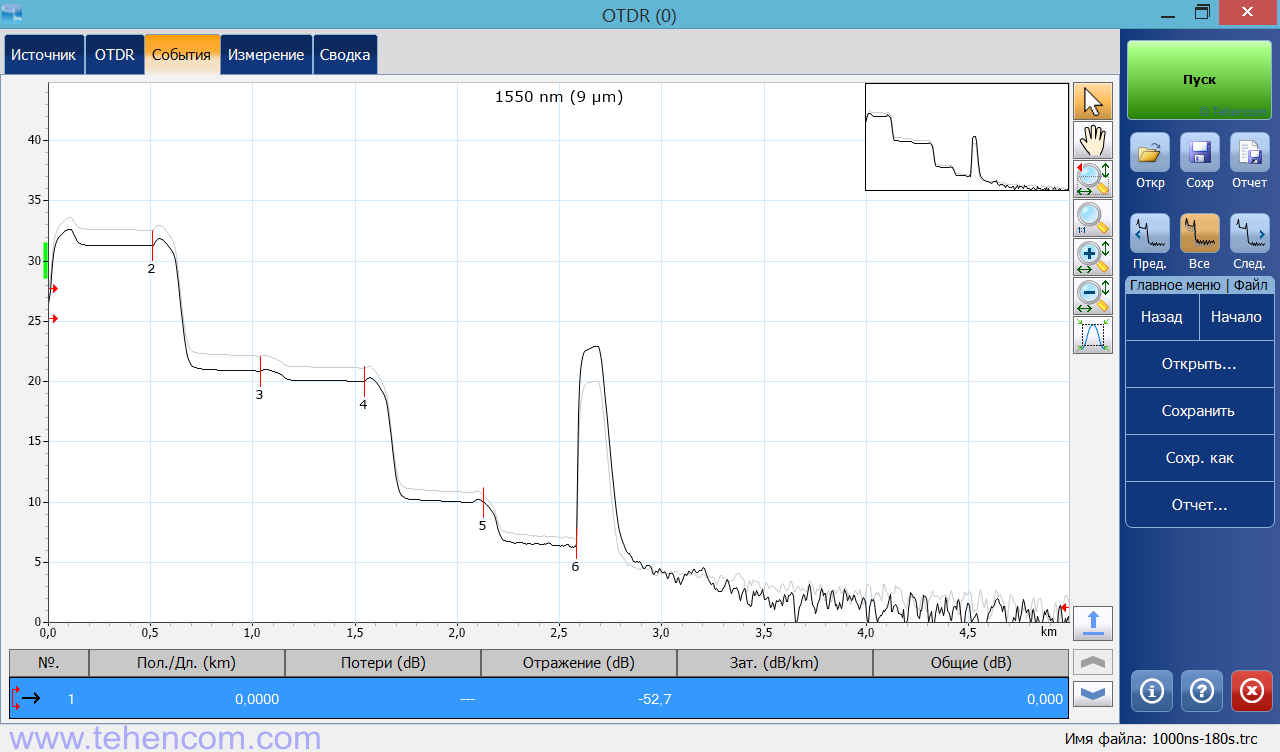
The results of splitter loss measurements are shown in the screenshots below. These results are only 0.1 dB different from those measured with the reference EXFO MAX 730C OTDR. The quality of the reflectogram is also comparable to the reference one. Click on the image of any of the screenshots to enlarge the image.
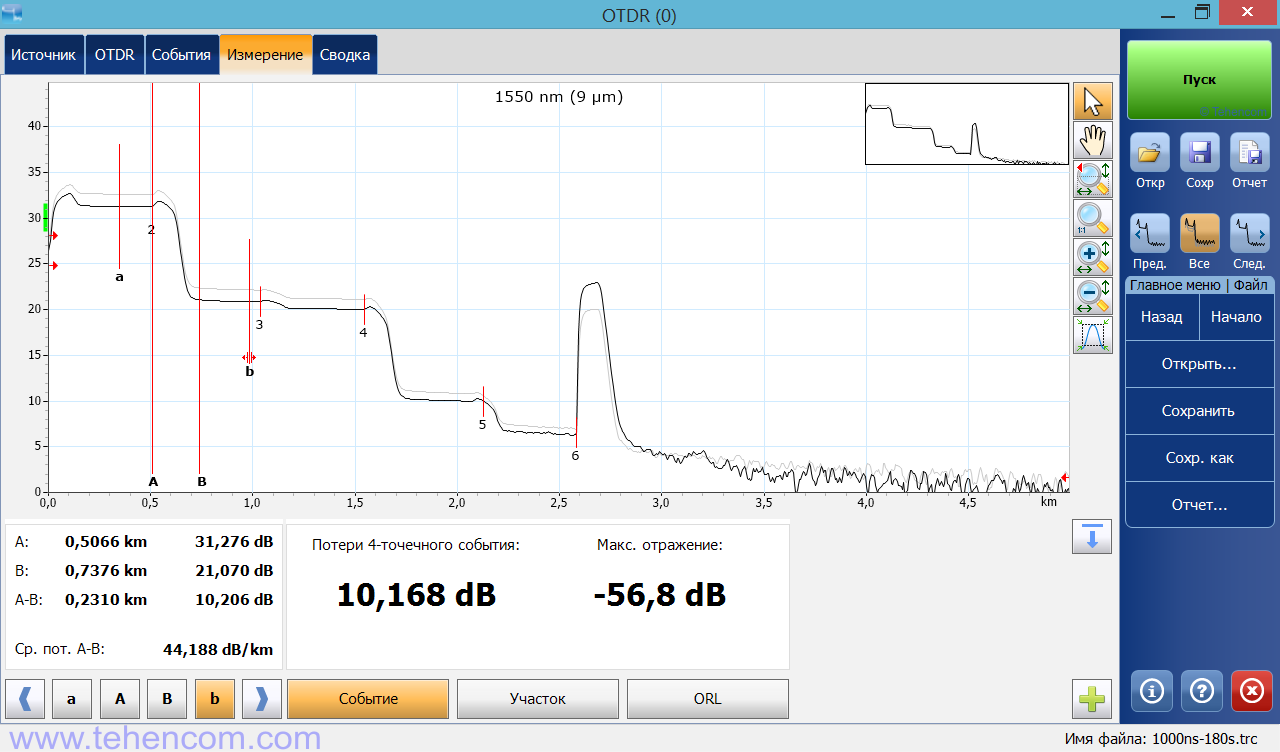
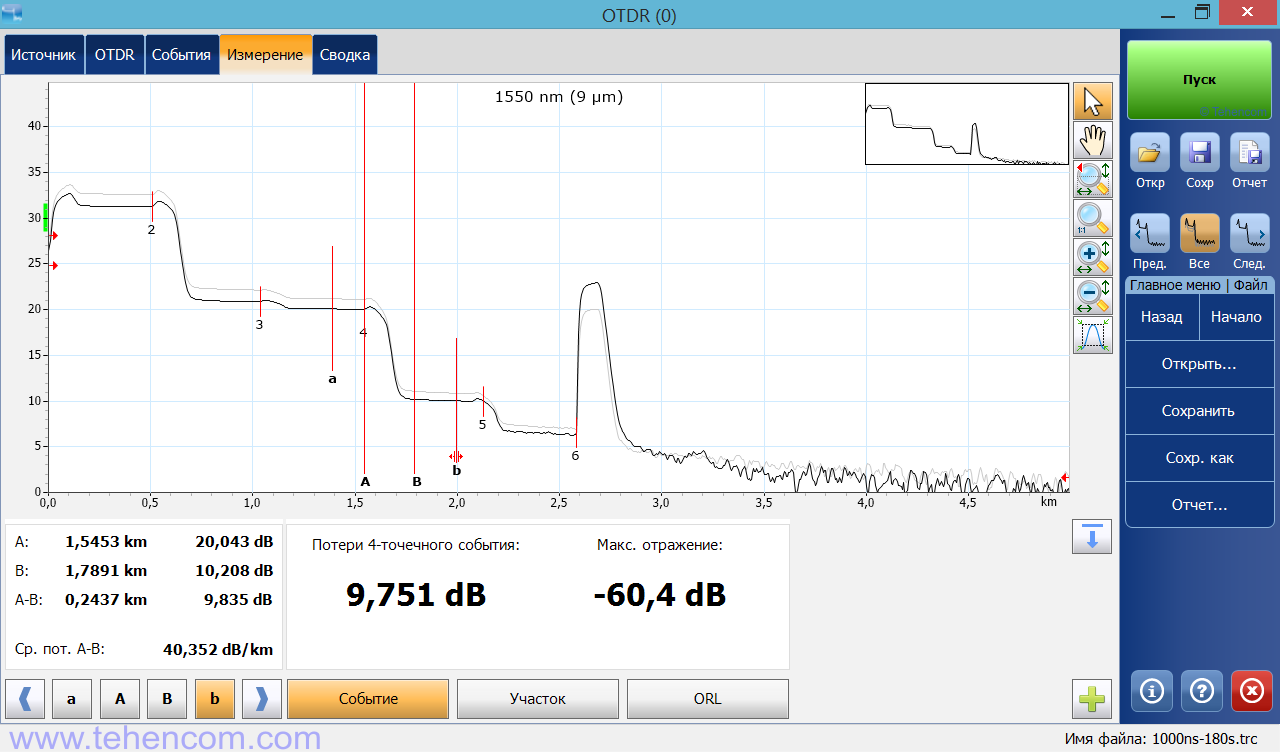
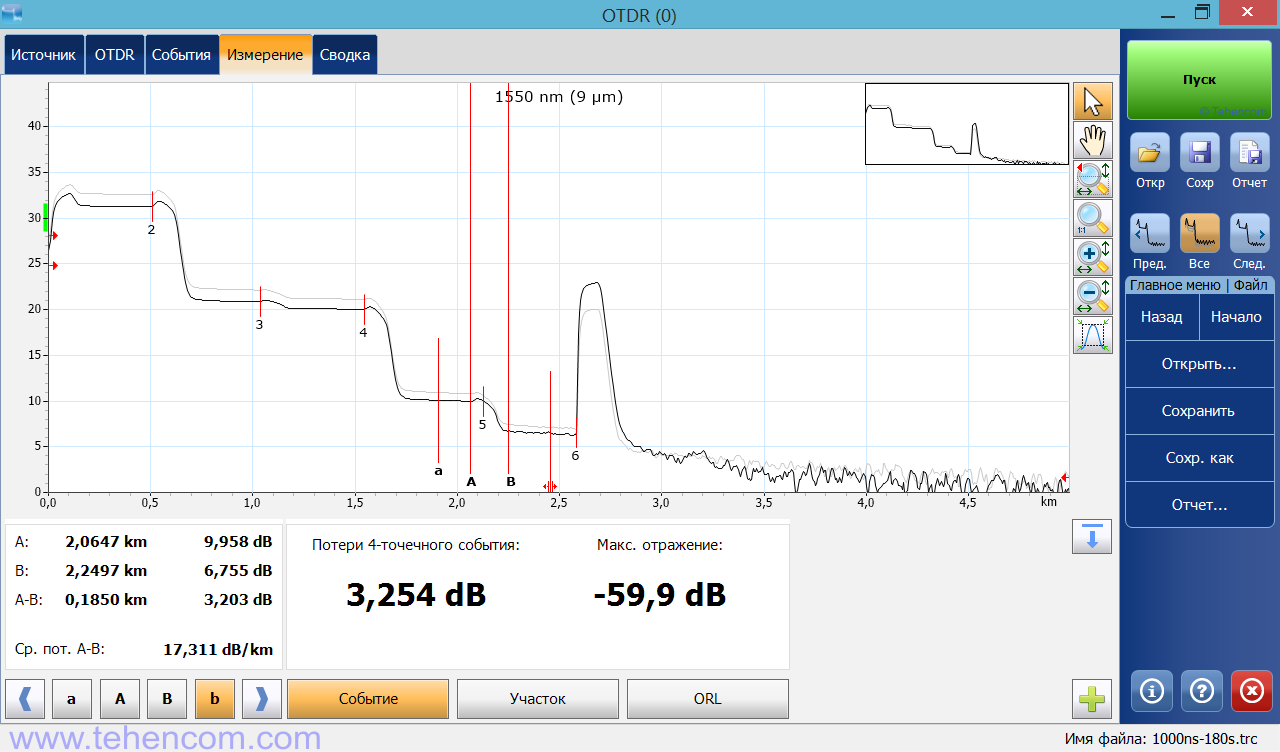
To show the dependence of the quality of the reflectogram on the duration of the probing pulse, we carried out a group of measurements with different pulses: 50 ns, 100 ns, 275 ns, 500 ns, 1000 ns (1 µs) and 2500 ns (2.5 µs). The averaging time was 30 seconds for each of the two wavelengths. The results are presented in this table..
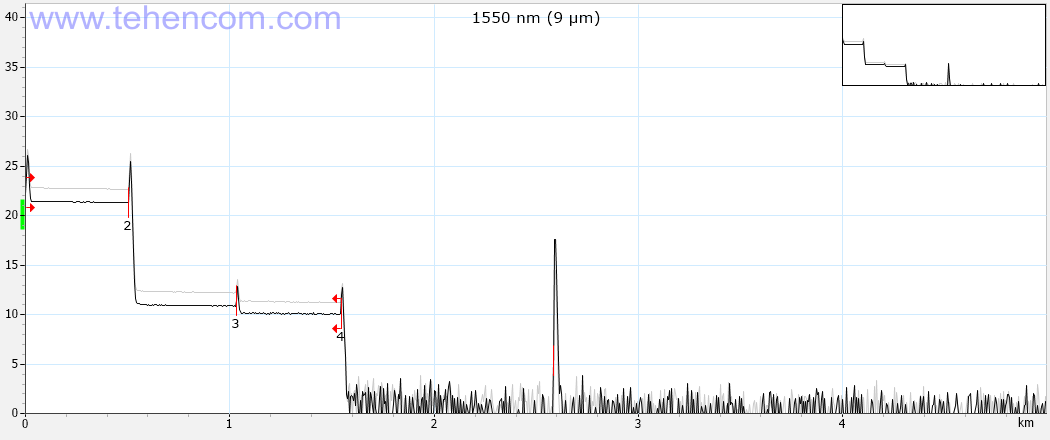
Test pulse 50 ns. |
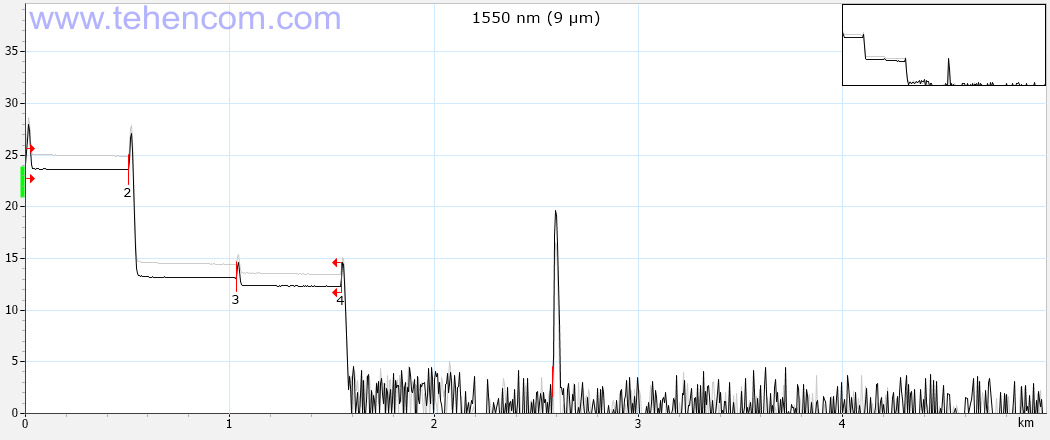
Test pulse 100 ns. |
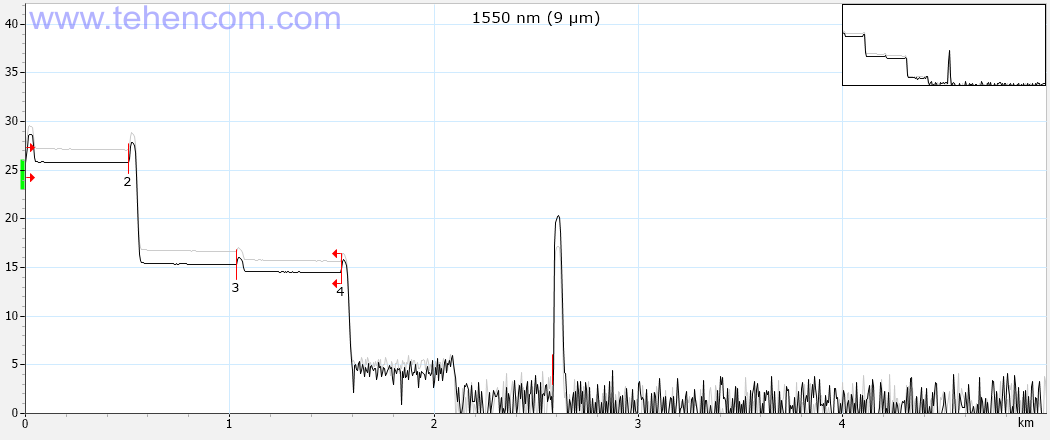
Test pulse 275 ns. |
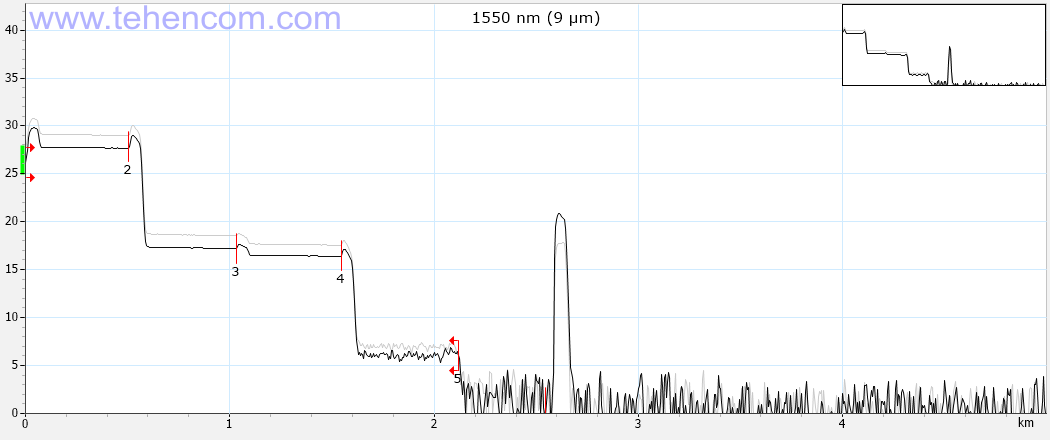
Test pulse 500 ns. |
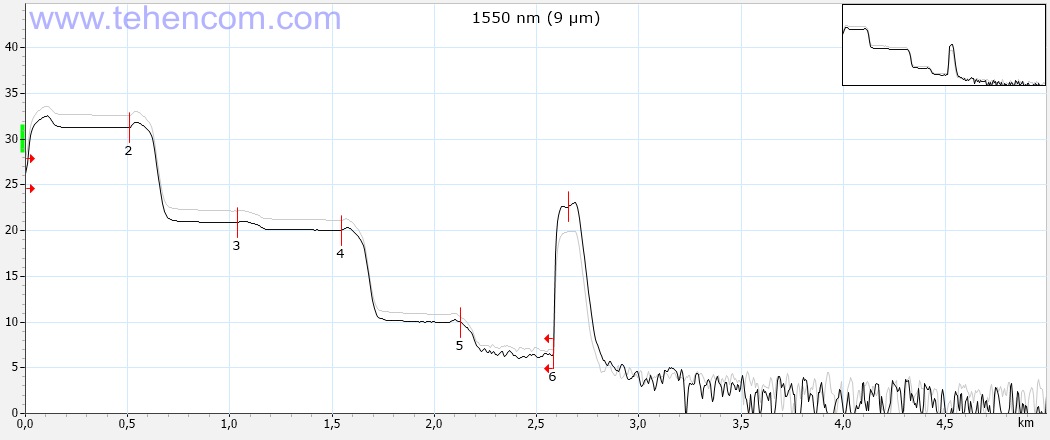
Test pulse 1000 ns (1 µs). |
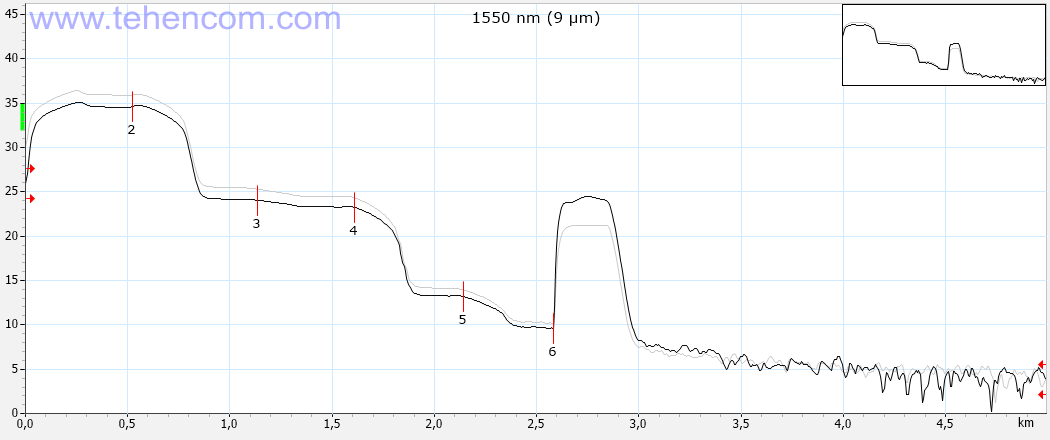
Test pulse 2500 ns (2.5 µs). |
Conclusions on the test results of the EXFO FTB-720C reflectometer. This reflectometer is well suited for PON networks with a division factor of 64. If it is necessary to test only the subscriber section and the first 1x8 divider, then the optimal pulse duration is 50 ns. With this pulse duration, the illumination from the 1x8 divider is only 35 meters, and if the second divider in the branch is at a greater distance, then the losses of the first divider can be accurately measured. If it is necessary to carry out measurements through two 1x8 dividers, then a pulse of 500 ns or 1,000 ns can be used, while the distance between the dividers should be more than 90 and 200 meters, respectively. In principle, the FTB-720C reflectometer can also be used on networks with a total factor of 128, but you will have to set a maximum averaging time of 3 minutes for each wavelength.
Measurement results Grandway FHO5000-T40F with 40 dB dynamic range
Optical reflectometer Grandway FHO5000-T40F belongs to the older series of reflectometers FHO5000 this manufacturer. The declared dynamic range of this device at a wavelength of 1310 nm is 40 dB. As with all reflectometers we have tested, the Grandway FHO5000-T40F has the best reflectogram The PON emulator obtained with a pulse duration of 1000 ns (1 µs) and an averaging time of 180 seconds. A screenshot of this trace is shown below. Note that the actual dynamic range (difference between input level and noise level) at this pulse width is about 20dB, which is 10dB less than the tested EXFO OTDRs.
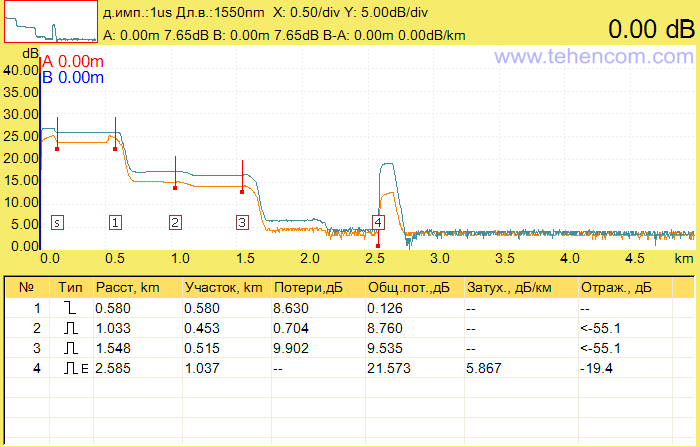
The results of splitter loss measurements are shown in the screenshots below. The Grandway FHO5000-T40F reflectometer measured the loss of the first splitter as 8.65 dB, which is 1.39 dB less than the value of the reference reflectometer EXFO MAX 730C. However, the difference in the second splitter is minimal, only -0.13 dB. When manually installing markers on the third splitter, we get a loss value of about 2.5 dB at a wavelength of 1550 nm, but given the overall noise level in the area of the third splitter and the fact that the losses at 1550 nm differ significantly from the losses at 1310 nm, it is correct to assume that that we see the presence of the third 1x2 splitter, but we cannot measure its losses with this reflectometer.
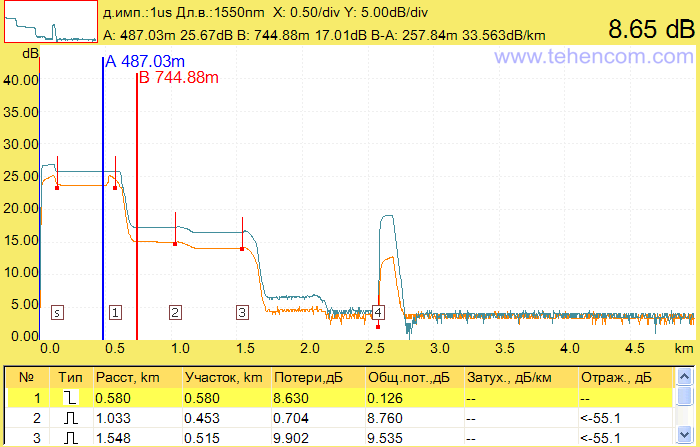
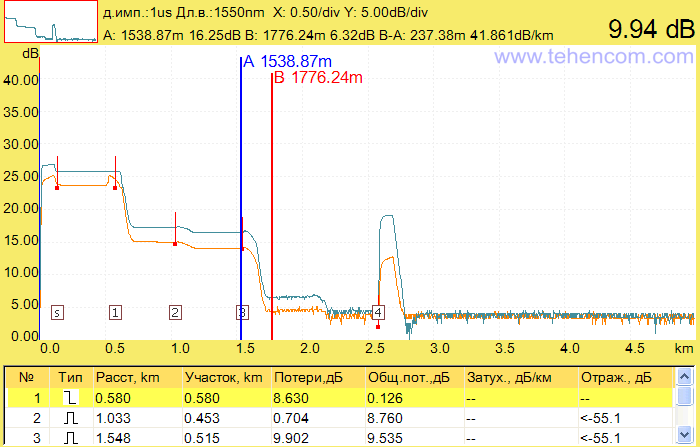
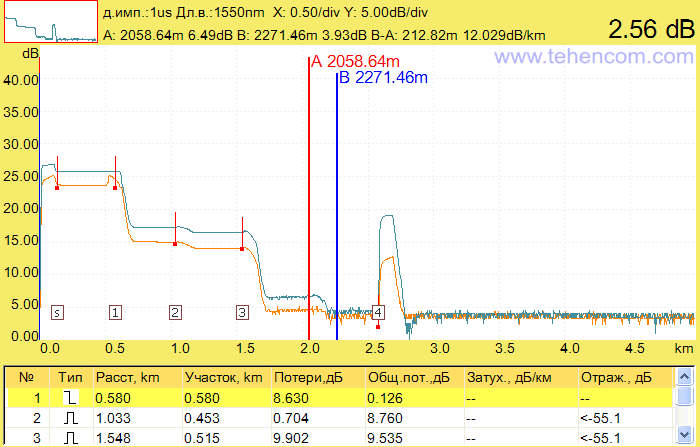
To show the dependence of the quality of the reflectogram on the duration of the probing pulse, we carried out a group of measurements with different pulses: 50 ns, 100 ns, 200 ns, 500 ns, 1000 ns (1 µs) and 2000 ns (2 µs). The averaging time was 30 seconds for each of the two wavelengths. The results are presented in this table. .
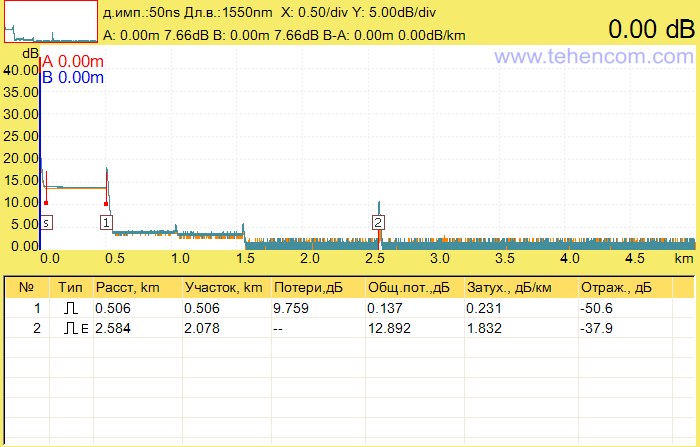
Test pulse 50 ns. |
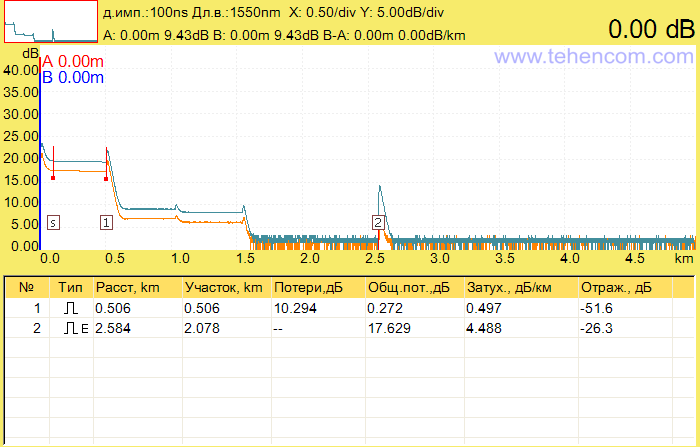
Test pulse 100 ns. |
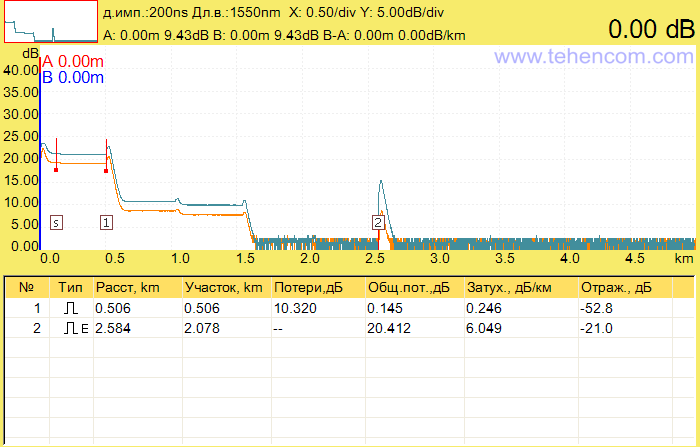
Test pulse 200 ns. |
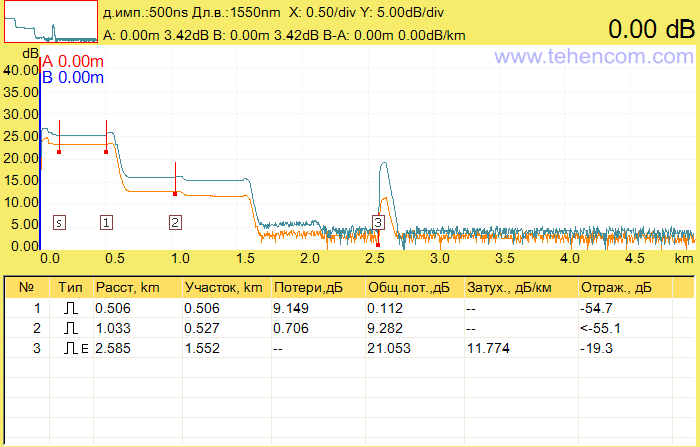
Test pulse 500 ns. |
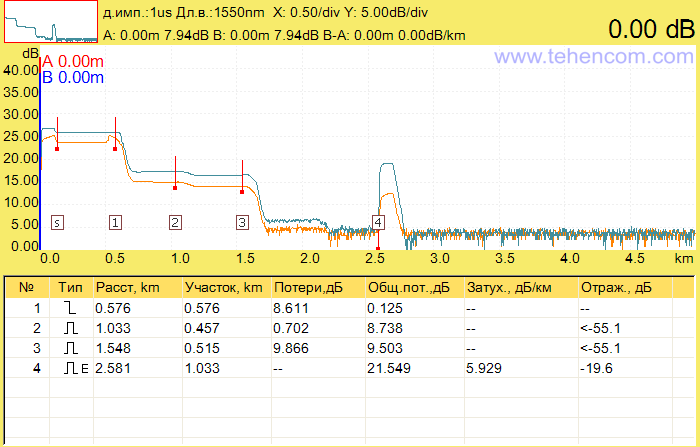
Test pulse 1000 ns (1 µs). |
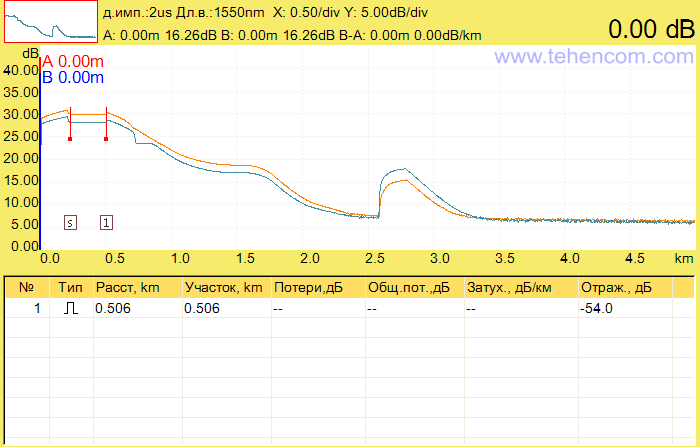
Test pulse 2000 ns (2 µs). |
Conclusions on the test results of the Grandway FHO5000-T40F reflectometer. With an impressive claimed dynamic range of 40 dB (at maximum pulse), the Grandway FHO5000-T40F reflectometer delivers about 20 dB at 500 ns and 1 µs pulses. The measured losses of the first 1x8 divider strongly depend on the duration of the test pulse. With a pulse of 1 μs, the loss is 8.6 dB. With a pulse of 500 ns, the loss is 9.1 dB. With a pulse of 200 ns, the loss is 10.3 dB. It is also worth noting that for pulses from 100 to 500 ns, the illumination after the dividers (the length of the nonlinear section) is on average twice as large as that of EXFO reflectometers, which means that for the correct measurement of two serial splitters, the distance between them must also be in two times more. However, given the budget price of the Grandway FHO5000-T40F reflectometer, it can be used for projects with limited funding. Wherein,
Measurement results Grandway FHO5000-D35 with 35 dB dynamic range
Optical reflectometer Grandway FHO5000-D35, as well as the previous model from this test, belongs to the older series of reflectometers FHO5000 this manufacturer. The declared dynamic range of the FHO5000-D35 at a wavelength of 1310 nm is 35 dB. When measured with this reflectometer PON network simulator, the best results were obtained with a pulse duration of 1000 ns (1 µs) and an averaging time of 180 seconds. A screenshot of this trace is shown below. Note that the actual dynamic range at this pulse width is about 19 dB.
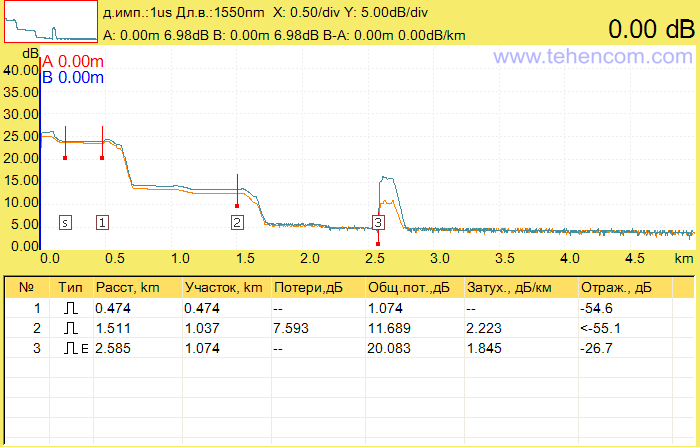
The results of splitter loss measurements are shown in the screenshots below. The Grandway FHO5000-D35 reflectometer did not show the loss of the first splitter in the event table, but when manually setting the markers, we get a value of 9.69 dB, which is 0.35 dB less than the value of the reference reflectometer EXFO MAX 730C. The loss on the second splitter measured with markers is 7.65 dB, which is 2.16 dB less than the reference value. The third 1x2 splitter is practically invisible on the reflectogram.
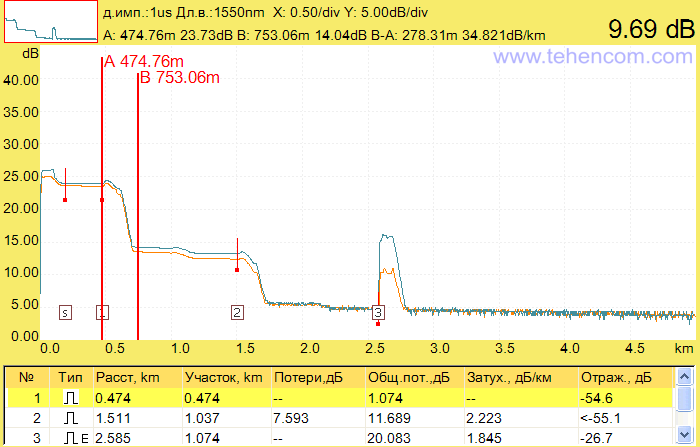
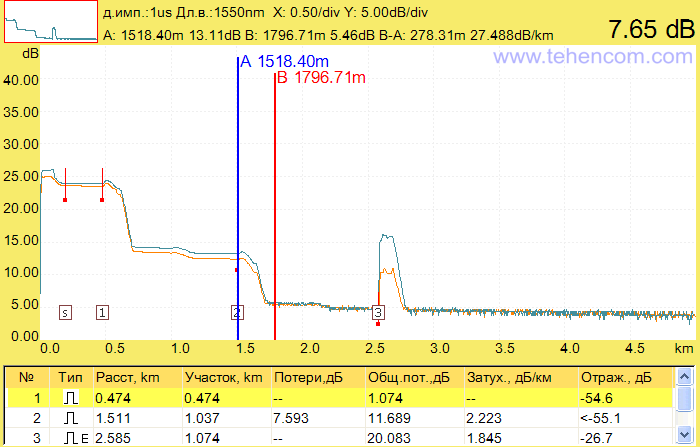
To show the dependence of the quality of the reflectogram on the duration of the probing pulse, we carried out a group of measurements with different pulses: 50 ns, 100 ns, 200 ns, 500 ns, 1000 ns (1 µs) and 2000 ns (2 µs). The averaging time was 30 seconds for each of the two wavelengths. The results are presented in this table. .
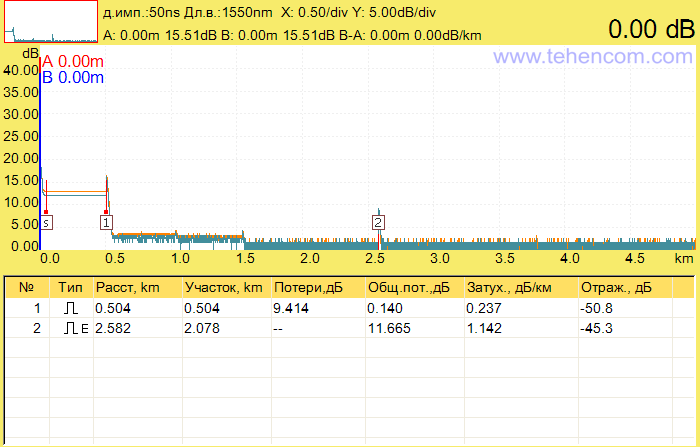
Test pulse 50 ns. |
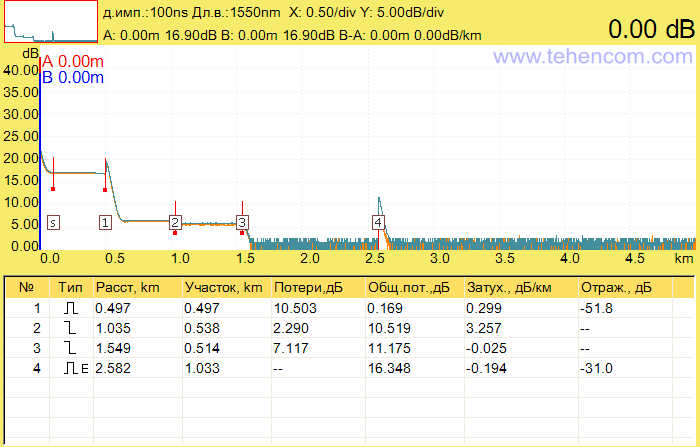
Test pulse 100 ns. |
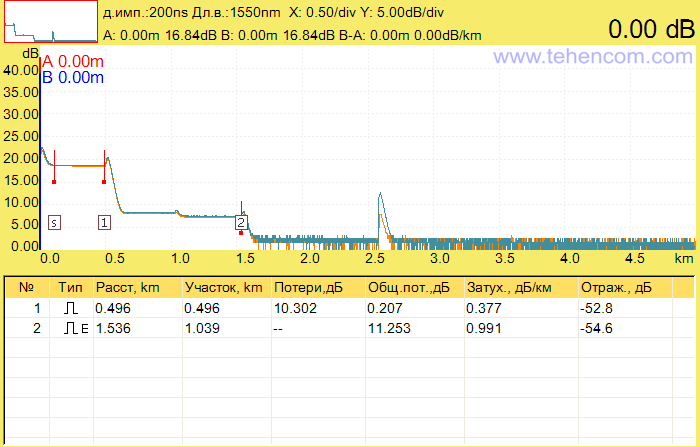
Test pulse 200 ns. |
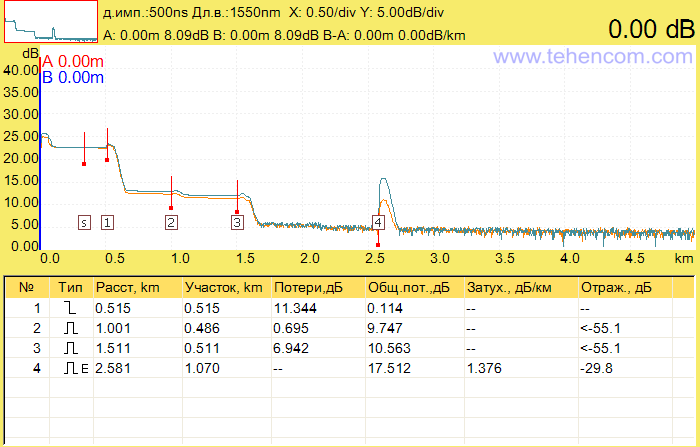
Test pulse 500 ns. |
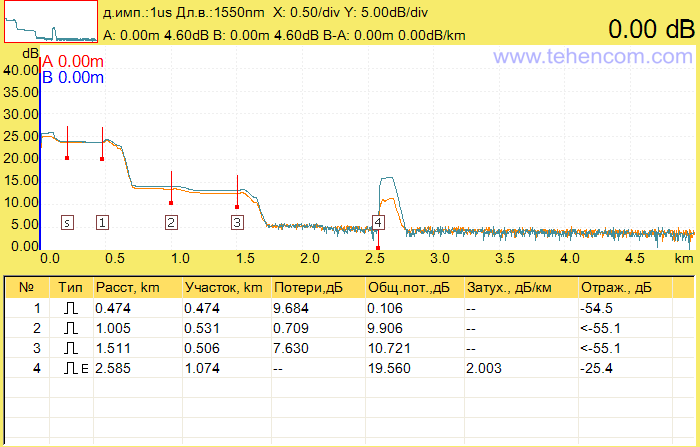
Test pulse 1000 ns (1 µs). |
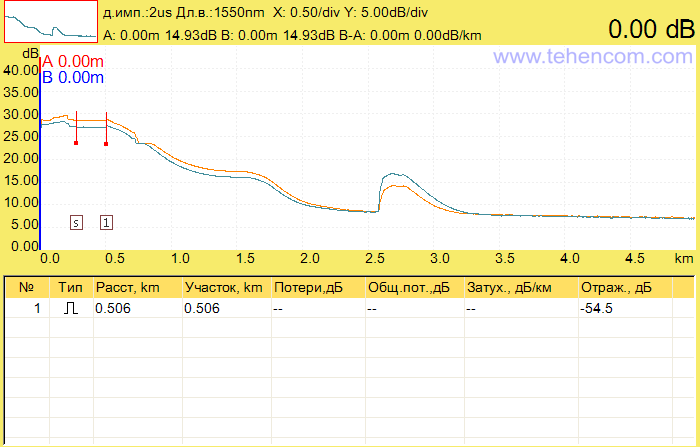
Test pulse 2000 ns (2 µs). |
Conclusions on the test results of the Grandway FHO5000-D35 reflectometer. The capabilities that this model demonstrated are very similar to the results Grandway FHO5000-T40F, although the dynamic range of the FHO5000-D35 is 5 dB less than that of the FHO5000-T40F. The same dependence of losses on the first divider on the duration of the test pulse is observed: the maximum value was 11.3 dB, and the minimum value was 9.6 dB. Illumination after the dividers is at the level of FHO5000-T40F and is on average twice as high as that of EXFO reflectometers. The price of the FHO5000-D35 model is significantly lower than that of a similar model by 40 dB, and if you have a very limited budget, but you still need to take measurements, then this reflectometer can be used to find breaks in an optical cable for PON networks with a common division factor in a branch no more than 64, but if necessary, measure the attenuation on the dividers, the error can reach 2 dB.
Grandway FHO3000-D26 measurement results with 26 dB dynamic range
Optical reflectometer Grandway FHO3000-D26 included in this test to show what OTDRs priced around $1,000 can do when trying to measure passive optical networks with them. Model FHO3000-D26 belongs to the junior series of reflectometers FHO3000 manufacturer Grandway. The declared dynamic range of the FHO3000-D26 at a wavelength of 1310 nm is 26 dB. Measurement results with this reflectometer PON network simulator, with a pulse duration of 500 ns and an averaging time of 30 seconds are shown in the screenshot below.
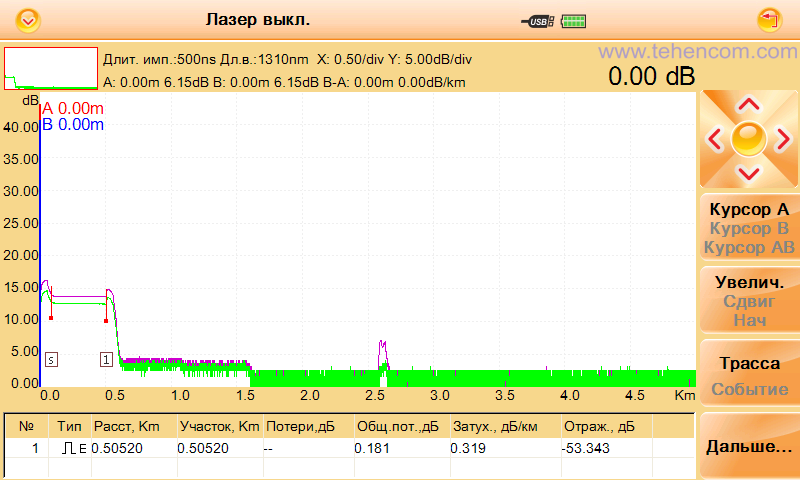
Due to insufficient dynamic range, the Grandway FHO3000-D26 reflectometer can only penetrate the first 1x8 divider. At the same time, immediately after the divider there is a rather high noise level. To accurately measure loss in the presence of noise, the four point (four marker) method must be used, and the FHO3000-D26 only allows two markers to be set on the screen. Therefore, we loaded the SOR file generated by the reflectometer into the EXFO ToolBox post-processing program and manually performed the measurement. The results for a wavelength of 1550 nm are shown in the screenshot below. I was pleasantly surprised by the fact that the losses on the first divider coincided quite accurately with the reference value. There was also no significant dependence of the measurement results on the pulse duration. With a pulse of 500 ns, the measured loss is 9.7 dB. With a pulse of 200 ns, the loss is 9.8 dB.
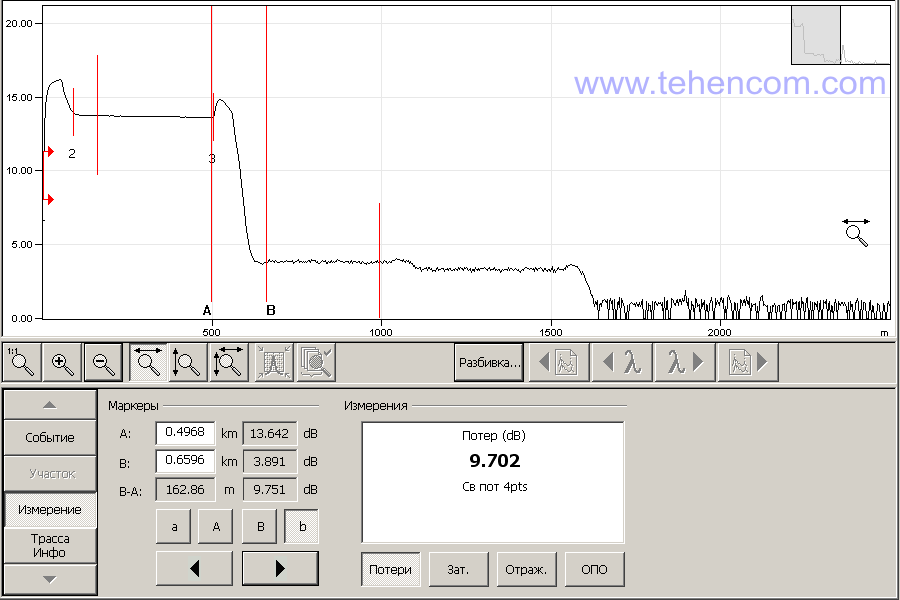
To show the dependence of the quality of the reflectogram on the duration of the probing pulse, we carried out a group of measurements with different pulses: 50 ns, 100 ns, 200 ns, 500 ns, 1000 ns (1 µs) and 2000 ns (2 µs). The averaging time was 30 seconds for each of the two wavelengths. The results are presented in this table. .
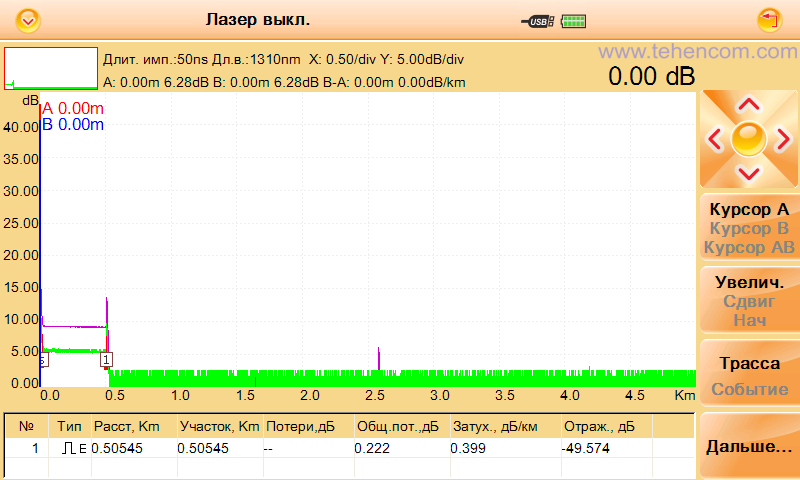
Test pulse 50 ns. |
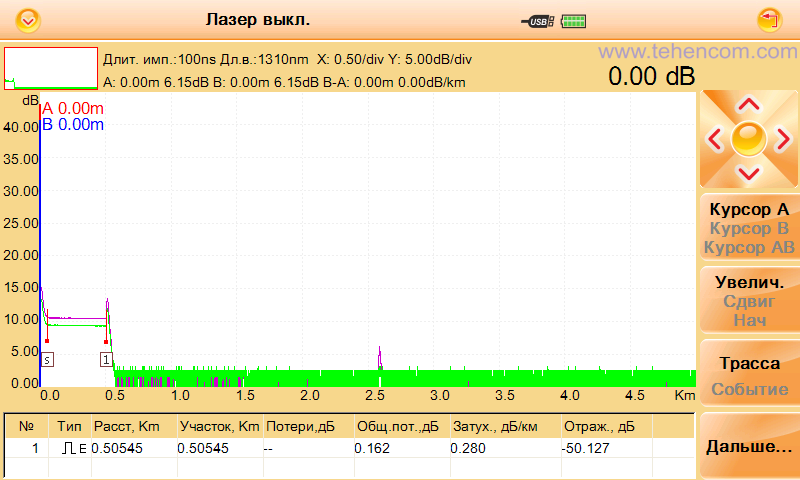
Test pulse 100 ns. |
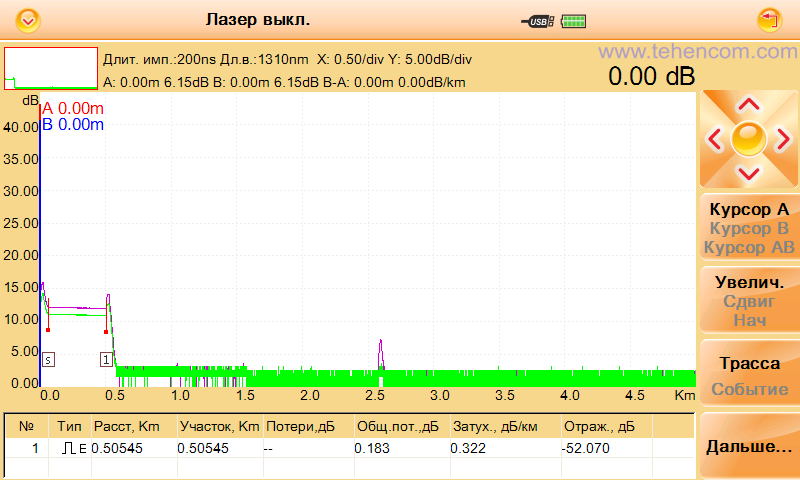
Test pulse 200 ns. |

Test pulse 500 ns. |
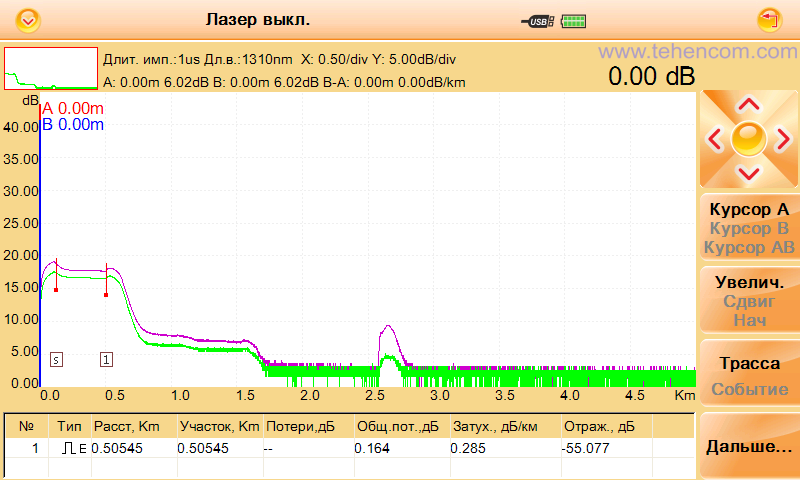
Test pulse 1000 ns (1 µs). |
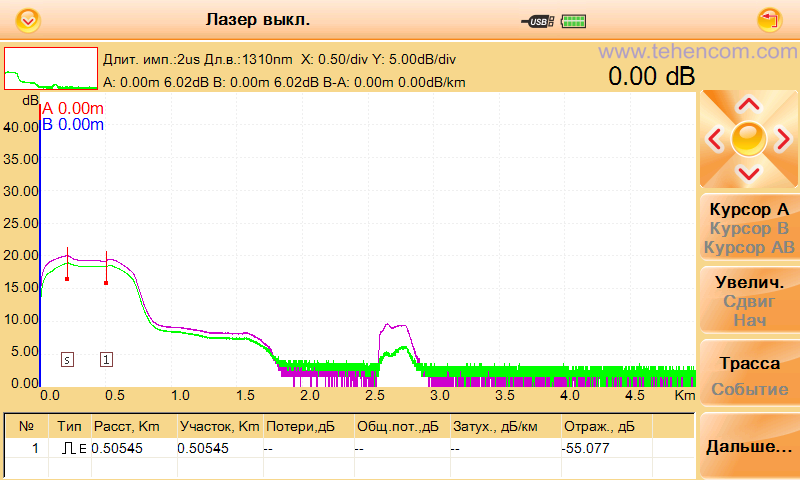
Test pulse 2000 ns (2 µs). |
Conclusions on the test results of the Grandway FHO3000-D26 reflectometer. This reflectometer belongs to the most economical segment and has a small dynamic range. Despite this, in the case of extremely limited funding, it can be used to diagnose faults in the area from the subscriber to the first splitter. Also with a pulse of 500 ns and a long measurement time (2-3 minutes), the FHO3000-D26 model can be used to measure the loss on the first 1x8 splitter (with an error of about 1 dB) and search for fiber defects in the area between the first and second splitters.
Video recording of measurements of all reflectometers from this comparison test
Above on this page, detailed measurement results of the PON network simulator using five popular models of optical reflectometers are presented. And in this 12-minute video, you can see how these measurements were carried out, as well as the features of each of the tested reflectometers. It is very interesting to see how different models behave during operation: how quickly noise is removed from the trace, whether software processing artifacts and other important features appear on the chart. This video will help you better understand each model.
General conclusions on PON testing at 1310 nm and 1550 nm wavelengths
The results of this comparative testing showed that for the correct measurement of passive optical networks, it is necessary to use specially designed level reflectometers EXFO MAX 730C. Such devices will provide accurate measurement results during the construction of the network, and during its operation will help to quickly detect and eliminate emerging problems.
Also, the test results showed that the large declared dynamic range of economy models (about 40 dB) does not help in any way to make accurate measurements of PON network elements. However, in a situation where the network is small, the purchase of the most budget devices may be economically justified. In this case, you need to be prepared for the fact that most economy models will be able to measure only the subscriber's section and the first divider. The best economy models will also be able to take a reflectogram of the section between the first and second dividers and, possibly, measure the losses on the second divider, but not very accurately. If you are going to buy a cheap reflectometer, be sure to test it on a real network before buying, as there are a lot of low-quality devices and empty advertising in this price segment.
In any case, we will be able to offer the optimal model of an optical reflectometer for PON, which will take into account your task and budget. For this it's simple call us or write to us at E-mail.
We also recommend that you read the article about principle of operation of an optical reflectometer, which describes how it works, provides detailed recommendations for choosing the initial settings and taking measurements. And to better navigate the models of modern optical reflectometers and their capabilities, see the main page individual series of optical reflectometers.